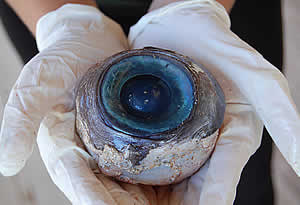From the Miami Herald:
Divers flock to see rebound of Goliath grouper
JUPITER --
The huge Goliath grouper seemed to be playing peek-a-boo with
divers hovering near the wreck of the MG III about 60 feet deep off
Jupiter. If the humans swam too close, the giant mottled brown fish
backed up deeper into the shipwreck. But if they held still and waited,
it edged closer — cocking its head to eye them, then opening its
cavernous maw so that they could see all the way down to its palate.
Not
far away, some other divers creeping up on scores of Goliaths puttering
around the wreck heard a deep boom that sounded like an orchestra
tympani or the penetrating bass of a rap song. That meant the humans
were invading the fish’s space, and it was warning them off using
vibrations from the muscles attached to its swim bladder.
Far from scared, the divers were elated.
“That was
so cool,” they told one another after surfacing at their charter boat, the Blue Tang.
In
a two-tank drift dive that covered three 90-foot-deep artificial reefs —
the Zion, Miss Jenny and Bonaire — followed by the shallower MG III,
the dozen divers probably had observed several hundred Goliath groupers.
Large schools of the huge, gentle giants began showing up on shipwrecks
from Boynton Beach to Stuart in July for their annual spawn, which
peaked in August and is expected to extend into mid-October.
Scuba
divers come from Florida, the United States and around the world just
to see the one-of-a-kind aggregation of huge fish now making a
resurgence after nearly being wiped out by overfishing in the 1980s.
Since the Goliath fishery’s closure in the South Atlantic and Gulf of
Mexico in 1990, the population has swelled, prompting some spearfishers
and hook-and-line anglers to call for its reopening.
But NOAA
Fisheries, the federal agency in charge of managing fish stocks in the
United States, and the Florida Fish and Wildlife Conservation Commission
have no plans to open the harvest of Goliaths anytime soon. Scientists
from the two agencies are expected to begin a stock assessment in 2015
to determine whether they have rebounded enough to allow any take. Chris
Koenig, a retired professor from Florida State University, and several
colleagues are gathering scientific data for that assessment. A lot of
their work is performed in the waters around Jupiter.
“It’s neat
they aggregate in such density,” Koenig said. “You can’t see that
anywhere in the world. Now the population is really building. They’re
doing well. They’re getting up there.”
Koenig and his fellow
scientists are trying to learn all they can about the giant groupers’
life history, movements, reproduction and diet. They have caught,
tagged, sampled and released more than 400 Goliaths off Jupiter in the
past two years — including a banner weekend of 80 in three days earlier
this month.
Working from captain Mike Newman’s commercial boat,
Dykoke, the scientists use heavy lines dangling from poly balls and
circle hooks baited with chunks of barracuda, jack, and bonito to catch
Goliaths on the wrecks. They handline the fish quickly into the Dykoke’s
cockpit and pump saltwater through its gills while they take a sample
of the fin rays for aging, biopsy the ovaries and collect sperm, pump
the stomach to see what it ate, collect genetic material, and implant
streamer and acoustic tags. Occasionally, a fish dies after being worked
up, which upsets divers who find it.
But Koenig said his team has
lost only three fish in two years — a tiny percentage of the 800 that
federal and state fisheries managers considered allowing them to kill
five years ago in order to take otoliths, or ear bones, for aging.
Koenig said they don’t need to harvest fish because they’ve developed
non-lethal techniques for sampling.
Since the mid-1990s, Koenig said, scientists have learned a lot about Goliaths:
• They eat mostly small, slow-moving fish and crustaceans, but very few lobster.
• They are hermaphrodites, harboring sperm and eggs in the same set of gonads in 5-10 percent of fish sampled.
• They can live to their 60s, beginning to spawn at about four feet long.
• As juveniles, they inhabit mangrove estuaries then move out to deeper water when they mature.
• They will travel long distances — as much as 180 miles — to reach summer spawning sites.
Unknowns
include: Do the fish spawn in pairs or groups? Can larvae harvested
during spawning be raised in captivity? And what is the exact
relationship between size and age?
Koenig urges anglers eager to target Goliath grouper to be patient and accept the findings of scientists.
“I
get sick of arguing about it,” Koenig said. “All this misinformation
they repeat to each other until it becomes truth. People believe their
buddies and not what science tells them. They want their cake now. It’s
hard getting through to them.”
Read more here: http://www.miamiherald.com/2012/09/27/3022594/divers-intrigued-by-goliath-grouper.html#storylink=cpy
Read more here: http://www.miamiherald.com/2012/09/27/3022594/divers-intrigued-by-goliath-grouper.html#storylink=cpy










 "Then
he saw three locals supporting what appeared to him as a monster from
the deep. He ran down to get a closer look and saw three locals
assisting the strange creature, which appeared to be in distress as it
struggled for air."
"Then
he saw three locals supporting what appeared to him as a monster from
the deep. He ran down to get a closer look and saw three locals
assisting the strange creature, which appeared to be in distress as it
struggled for air."



